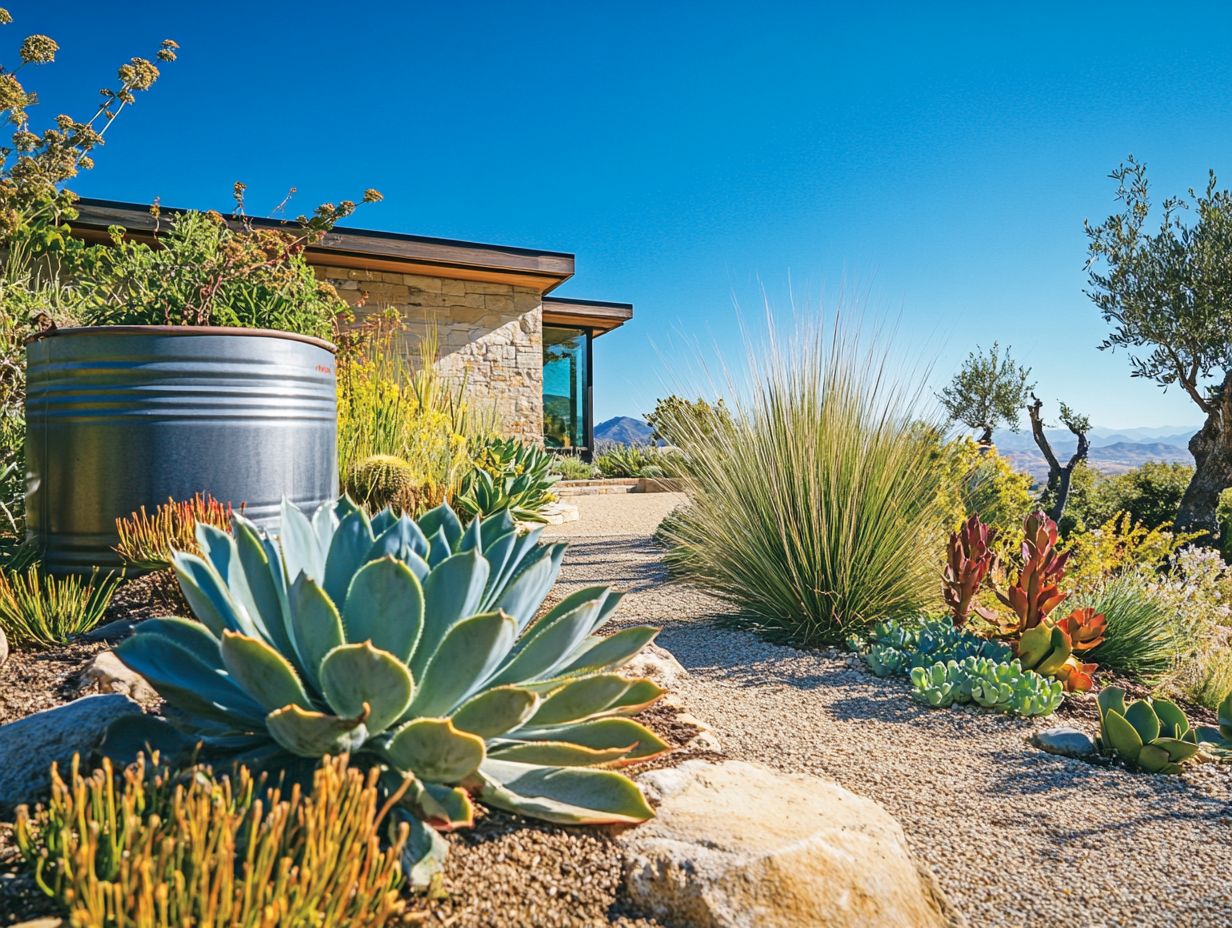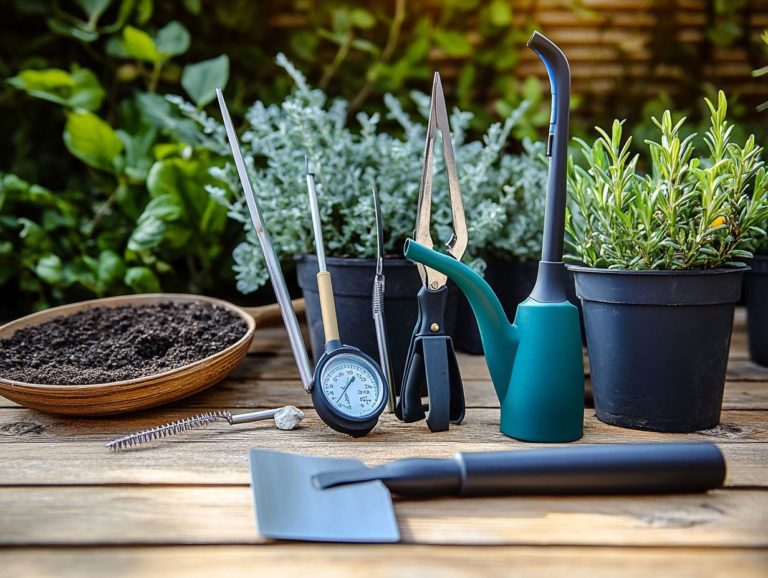Adapting Your Garden to Drought Conditions
Drought conditions present considerable challenges for gardeners, affecting everything from plant health to water availability.
Understanding what defines a drought and recognizing its various forms will empower you to navigate these difficult times with confidence.
This guide will provide effective water conservation strategies and insights on selecting drought-resistant plants to keep your garden flourishing. It also covers maintenance techniques and long-term planning to prepare you for future droughts.
Get ready to cultivate a garden that can thrive against the odds!
Contents
- Key Takeaways:
- Understanding Drought Conditions
- Adapting Your Garden to Drought
- Maintaining Your Garden During Drought
- Preparing for Future Droughts
- Frequently Asked Questions
- What is meant by adapting your garden to drought conditions?
- Why is it important to adapt your garden to drought conditions?
- What are some ways to adapt your garden to drought conditions?
- Are there certain plants that are better suited for drought conditions?
- How can mulch help with drought conditions in the garden?
- Is it possible to have a beautiful garden while still conserving water during a drought?
Key Takeaways:

- Understand what constitutes a drought and its effects on your garden.
- Adapt your garden to drought conditions by implementing water conservation strategies and choosing drought-resistant plants.
- Maintain your garden during drought by utilizing effective watering techniques and considering other maintenance factors.
Understanding Drought Conditions
Understanding drought conditions is essential for crafting a garden that flourishes in arid climates. Learning how to create a drought-resistant garden can help you manage not only the scarcity of water but also the disruption to the entire ecosystem, compelling you to adapt your gardening practices accordingly.
Drought conditions can vary widely, influencing how plants grow, soil health, and ways to keep water in the soil. By grasping what defines a drought and its implications, you can make informed choices that help you cultivate healthy gardens, resilient even in the face of these challenging circumstances.
What Constitutes a Drought?
A drought is typically characterized as an extended period of below-average rainfall, which can profoundly affect water availability and the overall health of ecosystems. This lack of precipitation does more than just shrink surface water supplies; it also disrupts groundwater levels, leading to challenges in managing these essential resources.
Farmers often face significant obstacles as their crops endure moisture stress, compelling them to adapt traditional moisture conservation practices. The consequences of drought can send shockwaves through local economies and ecosystems, underscoring the urgent need for effective water management strategies.
By grasping the various definitions and characteristics of drought, stakeholders can more effectively implement solutions to mitigate its impacts on water resources and bolster resilience against future occurrences.
Types of Drought and Their Effects
You ll encounter several types of drought meteorological, agricultural, and hydrological each impacting your garden in unique ways and requiring tailored approaches for preparation and maintenance.
Meteorological drought, marked by extended periods without sufficient rainfall, can significantly hinder the establishment of a thriving garden. In this situation, it s essential to enhance your soil health through organic amendments that improve water retention.
Agricultural drought, which specifically affects crop production, calls for strategic planning. This means opting for drought-resistant varieties that can endure prolonged dry spells and still flourish.
Hydrological drought, however, poses challenges to your water supply, complicating irrigation practices. By understanding these distinctions, you can implement effective strategies that ensure your green spaces continue to thrive, even in the face of adversity, ultimately fostering sustainable and resilient gardening practices.
Adapting Your Garden to Drought

Adapting your garden to thrive in drought conditions demands careful planning and the application of various water conservation techniques.
Consider creating a drought-proof garden that emphasizes native plants and adheres to effective plant selection criteria. For guidance on this, check out how to design a drought-tolerant garden. This approach not only conserves water but also enhances the overall resilience and beauty of your outdoor space.
Water Conservation Strategies
Effective water conservation strategies are crucial for keeping your garden flourishing during droughts. Techniques like rainwater harvesting and using mulch to retain moisture can make a significant difference, especially when creating a wildlife-friendly drought garden.
One practical approach is collecting rainwater in barrels. This water can then be used to irrigate your plants, ensuring they receive the hydration they need without relying solely on municipal supplies. Incorporating organic matter, such as compost, into your soil not only enriches it but also boosts its ability to retain moisture.
By applying a thick layer of mulch around your plants, you create a barrier that reduces evaporation, suppresses weeds, and maintains a consistent soil temperature. These methods promote sustainable gardening practices and ensure your plants thrive, even when faced with challenging weather conditions.
Choosing Drought-Resistant Plants
Choosing drought-resistant plants is vital for creating a resilient landscape capable of tackling the challenges posed by low water availability. This thoughtful selection not only elevates the aesthetic appeal of your garden but also fosters ecological balance.
Focus on native species when picking your plants. These varieties have adapted to thrive in your local climate, allowing them to endure extreme conditions with minimal care. Look for plants with special adaptations like deep root systems that tap into moisture stored in the soil or thick, waxy leaves that minimize water loss through evaporation.
By prioritizing these characteristics, you’ll cultivate a vibrant green space that thrives even during dry spells while supporting local wildlife and reducing your environmental impact.
Maintaining Your Garden During Drought
To maintain a thriving garden during drought conditions, carefully implement effective watering techniques and enhance your soil with organic materials. This approach supports deep root development and improves moisture retention, helping to boost your garden’s resilience with drought tactics, ensuring your plants flourish even in challenging circumstances.
Effective Watering Techniques

Using effective watering techniques, such as drip irrigation, can dramatically improve moisture conservation in your garden, especially during extended drought periods.
Drip irrigation delivers water slowly to the roots of your plants, cutting down on evaporation and minimizing runoff. This ensures that every precious drop benefits plant health. Techniques like soaker hoses and timed sprinkler systems help maintain consistent soil moisture levels, creating an ideal environment for growth.
Consider rainwater harvesting as a sustainable option. Collecting natural precipitation promotes efficient water use. These combined approaches enhance watering efficiency and support the broader ecosystem by conserving water resources and reducing the need for chemical fertilizers, ultimately cultivating a healthier garden.
Other Maintenance Considerations
Watering is just the start! Consider other maintenance practices, such as incorporating organic matter and establishing windbreaks or shelterbelts, to significantly enhance your garden’s resilience during drought.
Improving soil health is vital for retaining moisture and supplying essential nutrients to your plants. Increasing organic matter fosters beneficial microbial activity in the soil, leading to better water absorption.
Planting trees or shrubs strategically can create shade, mitigating temperature extremes and reducing evaporation rates. Choosing drought-resistant native species conserves water and supports a more sustainable ecosystem.
By embracing these integrated approaches, you can cultivate a landscape that thrives even in tough conditions, truly embodying resilience.
Preparing for Future Droughts
Preparing for future droughts requires implementing long-term solutions that cultivate a resilient landscape. Transforming your landscape for drought can help you embrace seasonal gardening practices and engage in strategic planning to ensure your garden thrives even in challenging conditions.
Long-Term Solutions and Planning
Identifying long-term solutions and engaging in thorough planning are paramount for you as a gardener eager to mitigate the effects of drought. By using drought-resistant plants and smart gardening techniques, you set the stage for a flourishing landscape.
This proactive approach conserves water and allows your garden to thrive amidst changing climate conditions. Choosing native plants that are well-suited to your local soil and weather can significantly enhance resilience. These species typically demand less maintenance while offering food and habitat for local wildlife.
Incorporating techniques such as mulching to retain moisture, implementing drip irrigation which delivers water directly to the roots of plants for efficient watering, and rotating crops in your garden can further solidify your sustainability efforts.
By embracing these strategies, you re not just nurturing your garden; you re contributing to a healthier ecosystem while ensuring that your outdoor space remains vibrant and productive, even in the face of an increasingly unpredictable climate!
Frequently Asked Questions

What is meant by adapting your garden to drought conditions?
Adapting your garden to drought conditions means making changes to help it withstand and thrive during periods of low water availability, as outlined in our guide on preparing your garden for drought conditions.
Why is it important to adapt your garden to drought conditions?
Drought conditions can negatively impact your garden, causing plants to wither and die. Adapting your garden by following guidelines on establishing a drought-tolerant garden helps reduce water usage and maintain a healthy garden during times of drought.
What are some ways to adapt your garden to drought conditions?
- Choose drought-resistant plants.
- Use mulch to retain moisture.
- Incorporate drip irrigation systems.
Are there certain plants that are better suited for drought conditions?
Yes, many plants are considered drought-resistant, such as succulents, cacti, lavender, and sage. These plants have adapted to survive in dry conditions and require less water to thrive.
How can mulch help with drought conditions in the garden?
Mulch is a great resource for retaining moisture in the soil and preventing evaporation. It helps regulate soil temperature and suppress weed growth, making it an essential tool for adapting to drought conditions in the garden.
Is it possible to have a beautiful garden while still conserving water during a drought?
Yes! It s possible to have a beautiful, thriving garden while conserving water during a drought. By choosing the right plants and implementing efficient watering techniques, you can create a drought-resistant garden that is both functional and visually appealing.
Start implementing these strategies today and watch your garden flourish, even in dry times!






